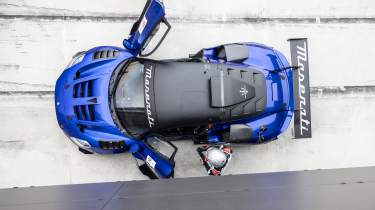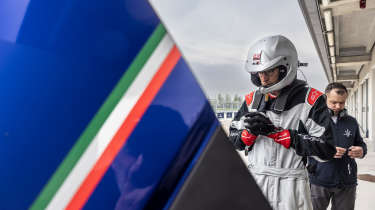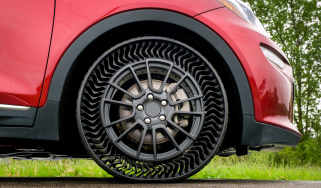Maserati MC20 GT2 2024 review – flat-out in the track-only V6 racer
The road-going Maserati MC20 was evo Car of the Year 2022, so great things are expected of the GT2 race version. We head for the Autodromo di Modena to find out if it delivers
There’s a fleeting clatter of gravel in the nearside arches. It’s Monday morning and most people seem in a hurry, including our driver. ‘Pronto’ is the pace, the fat Chrysler people-carrier threading its way surprisingly quickly along the narrow country roads outside Modena. No one is pausing politely, so occasionally a wheel drops off the tarmac and onto the loose stones of the verge, the Chrysler squeezed aside by the off-kilter line of a preoccupied Panda or commuting Giulia coming the other way.
A thin mist is hanging over the fields and farm buildings on either side of the road, waiting patiently for a spring sun to burn off its ethereal cloak. Our driver is well prepared, dark glasses already in place. The surrounding Emilia-Romagna landscape is flat, and through the windows I can see a fair way into the distance despite the mist. But I can’t spot anything that looks like a pit complex for the Autodromo di Modena. To be honest I had no idea there was a circuit near Modena, other than Fiorano of course.
> Maserati GranCabrio Trofeo 2024 review – a worthy rival to the Mercedes-AMG SL63?
Given that I’m going to be driving a Maserati race car, perhaps it’s appropriate that we should be travelling to a track that lives in the shadow of Ferrari’s famous test facility. After all, pretty much since the 250F, the Trident has lived in the shadow of the Prancing Horse. To some, that’s part of what makes it a much cooler company.
More reviews
The MC20 road car fits that mould too. A non-hybrid supercar with no wild downforce claims, it doesn’t initially jump out as the latest and greatest. Yet, as eCoty 2022 proved, it’s a fabulous car that should be high on anyone’s – real or fantasy – shopping list. And now there is a racing version; not in the GT3 category, obviously, as that would tread on the 296 GTB’s hooves, but in the slightly lower, GT2 class.
Not that GT2s are necessarily inferior in every area, it’s just that the regulations prioritise downforce and corner speeds less and powertrains more. The idea is that the GT2s should be fast but just a little more approachable for the (well-heeled) amateur driver. Certainly when we find the Autodromo – built in 2011 and nestled in the Marzaglia countryside due west of Modena – and hear the MC20 GT2 hammer past the pits for the first time it sounds pretty serious. Not a wild shriek but a menacing growl with real depth. There’s a really appealing timbre, both under full throttle and then with each of the blipped downshifts into the first corner. It’s got character and I think you’d pick it out in a grid.
As it rolls into the pitlane, falls silent and then pushes itself up on its air-jacks it looks serious too. Resplendent in a restrained combination of dark blue and bare carbon with just a thin tricolour stripe on the side, it is packed with purpose. The addition of a splitter, a snorkel, a wing and more scoops than the local gelateria all make it look much more aggressive but also somehow make it appear smaller than the road car upon which it is based.
And it really is related to its street-legal sibling, which was apparently designed from the outset with a racing model in mind. Much of the initial work was done on simulators, but, once brought to life, the road car’s central carbon tub remained, albeit with modified front and rear subframes. The twin-turbo 3-litre Nettuno V6 is also largely unchanged; the turbos and exhaust manifolds are altered and there are modifications for mating it to a six-speed sequential rather than the road car’s dual-clutch gearbox, but otherwise it is identical. The twin spark plugs, direct injection and clever pre-combustion technology are all present and correct. In its Balance of Performance trim, even the power and torque figures of 621bhp and 538lb ft remain the same as the road car’s, although the engineers are keen to point out that at least 100bhp more would be readily available if they ran unrestricted.
Where the road car has a multi-link set-up at the rear and split lower arms at the front, the GT2’s suspension is true double wishbones all round with shims for quick adjustment of the set-up. The adaptive dampers have obviously also been swapped out, the race car running two-way adjustable passive Ohlins. One aspect in which you might say the road car was superior is braking, given that its big carbon-ceramic discs have been swapped for iron items, but it makes sense given the frequency with which they will be replaced, and I somehow doubt that performance will be lacking.
Although aero is less of a priority compared with GT3 cars, the GT2 is still capable of generating over 1000kg of downforce thanks to its large rear wing, splitter, diffuser and flat floor. Look closely at the carbonfibre bodywork and you’ll see that a lot of consideration has also been given to pit stops, with little metal quick-release buttons dotted all over the car to allow rapid changes if a panel is damaged mid-race.
The dihedral doors ought to help in pit stops too, with their big upsweep allowing relatively easy access to the cockpit for driver changes. There is a roll-cage to climb through but the Sabelt driver’s seat is set back and fixed, with the pedal box and steering column being adjustable.
Once you’re inside, it initially feels like quite an intense place to be because the whole of the steering bone/bow/butterfly (it’s not a wheel) and all of the central panel are covered in highlighter yellow (I’ve settled on butterfly – ‘fluorescent farfalle’ has a nice ring to it). It has been done to make all the switches more easily visible in the heat of a race and, once you’ve adjusted to the psychedelic colour, it makes sense. What’s more, the switches on the main panel are all laid out in clear rows, with engine up at the top, then lights, then wet modes, then air for the cockpit. No need to play hunt the button.
It’s a layout that has its origins with Michael Schumacher. How so? Well, the man who has developed the MC20 GT2 is Andrea Bertolini. Now 50 years old, he was the youngest ever Ferrari test driver when he first drove out of the back gates onto Via Musso aged just 18, and over the years he’s become the only person to drive every single Ferrari F1 car (as well as being a multiple champion in GTs). Back in the early 2000s, local boy Bertolini was testing alongside Schumacher as well as developing the MC12 race car, and the German’s attention to detail in terms of cockpit layout and feeling comfortable in a car made a real impression on Andrea. He took what he learned and has applied it to cars ever since, including to the MC20 GT2.
For my handful of laps I won’t need to remember things like where the fuel reset is, but I am interested in how quickly I’ll feel at home in the car. If it’s meant to be for amateurs then I figure I should be able to get comfy pretty quickly. A bit like wandering round a sofa shop on a Saturday, you don’t need to spend too long rearranging the scatter cushions to know when you feel at home and what you’ll want to spend hours sitting on searching for something to watch.
Flip down the red covers on the ‘main’ and ‘ignition’ switches (oddly satisfying) and then, when the Bosch screen in front says you can start, you can press either of the red start buttons (one on the wheel, one on the central panel) to bring the 90-degree V6 to life. The thin carbon paddles have a light action and, although the clutch would be considered atrocious in a road car, it’s relatively amenable for a race car in a juddery sort of way and the flexible, torquey engine helps.
Rolling down the pitlane, the sound filtering through my Stilo is enjoyable rather than cacophonously intimidating and, although there’s a big sunstrip across the windscreen, the view out includes the louvred tops of the front arches, so there’s an instant sense that this will be an easy car to place in the corners.
The first part of the autodromo is tight, second-gear stuff with a right-left-right snake that’s a bit constricting but lets you get a feel for the car. Getting heat into the slicks is a priority at this point but I also notice that although there’s plenty of room in the pedal box, something about the ergonomics just seems better set up for left-foot braking. Luckily the pedal itself has a surprisingly generous amount of give. I’ve driven some race cars that have brake pedals with all the progression of pavement underfoot, but the MC20 GT2 feels more road car in the amount of travel that you can press into. The ultimate stopping power is of course prodigious, but it feels friendly in the way you access it.
There’s an Omega-shaped section of the circuit that we’re bypassing today, so the back straight stretches out with a crest in the middle that’s prominent enough to elicit a fun flurry of wheelspin as the car goes light. Then it’s another big stop into a more open, third-gear right that flows into a long left, followed by a right kink, a short squirt and then a tight right that runs out over the Modena-appropriate blue-and-yellow kerbing onto the main straight back past the pits.
There’s variable ABS and traction control to lean on but with both turned down to 2 there’s no noticeable intrusion. Lots of torque gives a cushion of flexibility to gear choice and also means that you can really use the throttle to help turn in the tighter stuff. But just as it does in the road car, the turbocharged V6 also feels absolutely wild when you fully uncork it. There is a thrilling, almost runaway train way in which the revs just pile on with the boost. It’s not laggy, but it is a bit feral in a way that modern engines often aren’t, and I love it.
Given this character, I’d been worried that the GT2 might feel snappy right at the limit and hard to correct with the non-round wheel in my hands, but piling on the throttle out of turn three onto the back straight I can feel the rear wheels just start to over-rotate nicely with the boost and the car almost floats wide over the kerbs with an easily administered few degrees of correction. Once I’ve discovered this, my confidence grows and I find I’m actually looking at the predictive lap times on the screen. It’s not a car that’s bubbling with texture and feedback, but for something with over 600 turbocharged horsepower it’s also a very smooth, surprisingly undemanding race car to drive in many respects.
Some of the reason for this becomes immediately obvious when I hop into the passenger seat for a few laps with Bertolini. Quiet and calm outside the car, he’s indecently fast in it, lopping chunks off my braking points and applying full throttle brutally in places where I was feeding it in. I’m also not sure I have ever seen someone with smoother, more precise inputs to a steering wheel. He’s almost uncannily serene and a joy to watch.
Much of the MC20 GT2 is, of course, competition-specific, but there are rumours that things will go full circle and that this race car will inspire a GT2 road car at some point down the line. Given the sometimes very GT-like qualities of the standard MC20, it certainly feels like there is ample headroom for a more extreme version, and a Maserati to take on a GT3 RS or Huracán STO is a truly tantalising prospect.
But what to conclude about this MC20 GT2 race car? Competition cars are always a little hard to rate. It’s often just about drinking in the experience. If it’s something older that has won races then there is usually a bit of daydreaming and perhaps a sense of connecting with a piece of palpable history. But the MC20 has yet to write its story. It claimed a pole position and then a second place in its first ever race at the end of the 2023 Fanatec GT2 European series, so the future looks promising, but who knows?
However, what I can say is that after only a few laps the MC20 GT2 left me wanting to go racing. It might seem an obvious observation, but it’s actually a pretty big compliment. It’s been well-documented that I’m a rally person at heart and racing has never quite done it for me. To be honest, I find the whole idea of going racing quite nerve-wracking. Something about the direct competition perhaps or the big stage and razzmatazz of a circuit. Give me a muddy service park any day.
But this car made me feel so confident and comfortable in such a short time that I could genuinely imagine tackling a race weekend in it and having fun rather than just being intimidated. I very much doubt I’ll ever have the opportunity to line up on a GT2 grid unless my numbers come up but, staring out of the window as the Chrysler cuts an apex on the rapid return journey to the airport, it’s nice to add another daydream to the list.
This story was first featured in evo issue 321.











